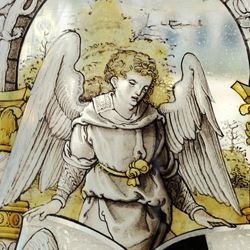Augustin
Hirsvogel (Hirschvogel, Hirsfogel)
stained glass painter, draftsman, copperplate engraver, medallist, cartographer,
born Nürnberg, 1503
died Wien, 1553
* 1503 Nuremberg
† Feb./April 1553 Vienna.
Son of Veit the Elder, glass painter. ∞ N. N. Probably pupil of his father and probably employee in the workshop until his death. In 1522, together with his brother Martin, he acknowledged the receipt of his inheritance from his deceased sister Ottilia. In 1528 he and his brother Veit the Younger sold their father's property. According to the fire record of 1529 he was a resident of Hirschelgasse, at that time still unmarried. He was self-employed at that time, but had to struggle with financial difficulties. He was also engaged in the production of antique stoves, jugs and pictures at this time, which led to the protest of the stove-fitters; however, they were rejected by the council. In 1531 Hirsvogel had himself instructed by Oswald Reinhard and Hans Nickel in "Venetian work" (probably the production of majolica). On 14.7.1533 he is mentioned as the apprentice of the goldsmith journeyman Paul Schütz. The latter had broken off his apprenticeship with him as a stone cutter, whereupon the apprentice demanded 30 fl. in outstanding apprenticeship fees from him.
Until 1536 Hirsvogel worked in Nuremberg; 1536-43 he stayed in Hungary and Transylvania, among others in Ljubljana, where he also worked as a cartographer, without giving up his Nuremberg citizenship. In 1543 he was again briefly in Nuremberg, where Mathes Gebel made a medal on him.
In 1544 he settled permanently in Vienna, where he created various plans and views of the city on behalf of the city and was appointed city cartographer.
However, he remained attached to his hometown and had maps printed here by Hans Weigel the Elder. He temporarily ceded his copper engraving plates for the "Perspectiva" as well as other "plech or form, so für goldtschmidt dienlich" in pledge to Ulrich Starck, who returned them to Hirsvogel's agent Johann Preil on April 21, 1548.
Hirsvogel was one of the most versatile artists of the 16th century.
In May 1560 his widow was mentioned. Panzer recorded his portrait, on which he presented himself with globe and compasses.
Works: Ein aigentliche vnd gründtliche anweysung, in die Geometria: sonderlich aber, wie alle Regulierte, vnd Vnregulierte Corpora, in den grundt gelegt, vnd in das Perspectiff gebracht, auch mit jren Linien auffzogen sollen werden. Nuremberg, Johann vom Berg & Ulrich Neuber 1543.
MuS: BOSTON, Mus. of Fine Arts.
BRAUNSCHWEIG, Duke Anton Ulrich Mus.
LOS ANGELES, County Mus.
MUNICH, BNM.
NÜRNBERG, GNM; -, MStN: drawings; stained glass in the Cloth Palace.
SAN FRANCISCO, Fine Arts Mus.
St. PETERSBURG, Hermitage.
WASHINGTON, D. C., Nat, Gallery of Art.
Lit.: ADB; NDB; Thieme-Becker; Doppelmayr; Will, GL II, p. 137 u. VI, p. 101; Will, Münzbel. Vol. III, p. 185; Imhoff II, 1782, p. 595; Carl Friedrich: A. H. als Töpfer, seine Gefäßentwürfe, Oefen und Glasgemälde, 1885; Max Wingenroth: Kachelöfen und Ofenkacheln, in: GNM M 1900; Hampe, Rv. ; Habich, 1916; Habich, Schaumünzen; K. Schwarz, 1917; M. Bernhart, in: MBNG, 1936; Schnelbögl, in: MVGN 51, 1962; Ursula Knappe: Die Glasmalerfamilie Hirsvogel, in: Fränk. Lebensbilder V, 1972; Rainer Gebhardt (ed.): Verfasser und Herausgeber mathematischer Texte der frühen Neuzeit. 2002, S. 237-251.
Issued: 1952/5; 1955/4; 1957/5; 1958/5; 1966/3; 1986/7; 2003/3 no. 16.
(quoted from the Nuremberg Künstlerlexikon, edited by Manfred H. Grieb)
Style: Renaissance
Period: 16th c.
